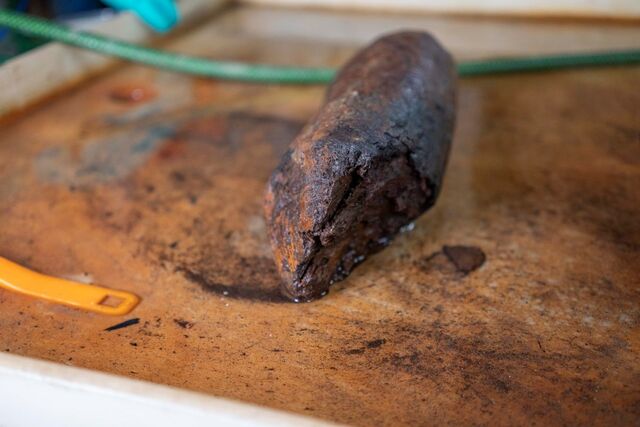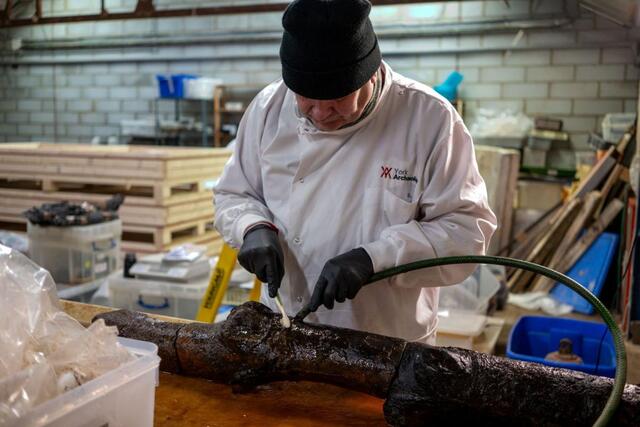In the heart of Sheffield, a remarkable archaeological discovery is shedding light on one of the most tumultuous periods in British history: the English Civil War. Excavations at Sheffield Castle have uncovered the remnants of the first surviving wooden stake defenses from the Civil War era. These findings, uncovered in the castle’s moat, provide a rare glimpse into the defensive strategies used during the conflict that divided Britain. As part of the Castlegate regeneration project, this discovery opens a new chapter in understanding how the castle and its residents experienced the brutality of war and the shifting tides of power during the 17th century.
Discovery of the Wooden Stake Defenses
During a recent excavation, archaeologists uncovered several wooden stakes in the moat surrounding Sheffield Castle. These stakes, approximately one meter in length, were made from ash and elm and were crudely sharpened to a point. They were found in the castle’s moat, which was once a crucial part of its defense. The stakes formed an “abatis,” a type of defensive barricade, positioned in front of the castle’s medieval gatehouse. The discovery is significant for several reasons, not least because it is one of the first times that these types of Civil War-era defenses have been uncovered intact in Britain.

Unlike many other Civil War sites, where records describe the presence of such defenses but no physical evidence remains, the stakes found at Sheffield Castle give us a direct connection to the past. These wooden stakes were carefully placed to create a formidable obstacle for attackers. The chaotic arrangement of the stakes indicates that they were part of a carefully planned “killing zone,” designed to slow down or trap the enemy while exposing them to the defenders’ fire.
Video
Watch First Ever Civil War Stakes Discovered at Sheffield Castle Site to uncover this remarkable historical find. A fascinating look into England’s past!
The Abatis: A Tactical Defense
The abatis, as used in Sheffield Castle, was a defense strategy that relied on the use of sharpened tree branches. These branches were cut and shaped quickly, often under duress, and then planted at sharp angles to create an almost impenetrable wall of spikes. The purpose of the abatis was twofold: to impede the attackers’ advance and to provide a clear line of sight for defenders, who could use the elevated position of the castle to strike with greater efficiency. This method of fortification was commonly used throughout the English Civil War but is rarely preserved in such detail.

The stakes uncovered at Sheffield Castle are particularly interesting because they were not only part of an immediate defense effort but also serve as a snapshot of the frantic atmosphere surrounding the castle’s siege. The hastily made stakes suggest that the defenders were under immense pressure and had little time to refine their fortifications before the Parliamentarian forces arrived. The very fact that these stakes were carefully deposited in the moat after the siege offers a glimpse into the mindset of the defenders, who may have used these objects as ritual offerings, hoping for protection or good fortune during the conflict.
The Siege of Sheffield Castle: A Turning Point

The Siege of Sheffield Castle in 1644 is a significant event in the broader context of the English Civil War. As Parliamentarian forces closed in on the castle, the defenders relied on the abatis and other fortifications to hold their ground. Despite these efforts, the castle ultimately succumbed to the Parliamentarian forces after a 10-day siege. The failure of these defenses serves as a reminder of the volatility and violence of the Civil War, as well as the challenges faced by those who were caught in the conflict.
After the fall of Sheffield Castle, Parliamentarian forces ordered its destruction. This act, known as “slighting,” was intended to prevent the castle from ever being used as a stronghold again. The remnants of the castle, including the timber and other materials from the siege, were buried in the moat, preserving the wooden stakes for centuries. The destruction of Sheffield Castle marked the end of an era for the city, symbolizing the shift of power from Royalist forces to the Parliamentarians and reflecting the broader societal changes of the time.
Rare Preservation of the Stakes
One of the most remarkable aspects of this discovery is the exceptional preservation of the wooden stakes. Typically, wooden artifacts from the Civil War era do not survive, as organic materials tend to decay over time. However, the stakes were buried in the waterlogged conditions of the castle’s moat, which created an oxygen-free environment that prevented decay. This unusual preservation allows archaeologists to study the stakes in greater detail, providing valuable insights into the craftsmanship and haste with which they were created.
The stakes also bear visible tool marks, suggesting they were crafted quickly and under pressure. Some of the stakes still have bark on them, indicating that they were freshly cut and not refined for aesthetic purposes. The rough axe marks on the wood further support the theory that the defenders of Sheffield Castle had little time to prepare, working in a frantic race against the approaching Parliamentarian forces.
The Archaeological Excavation and Team Insights
Led by Wessex Archaeology, the excavation at Sheffield Castle has provided significant new information about the Civil War defenses in the region. The team of archaeologists has uncovered not only the wooden stakes but also other important elements of the castle’s history, including remnants of medieval walls and evidence of the once-thriving community around the castle. The discovery of the stakes is a key piece of the puzzle, offering a deeper understanding of the defensive measures employed during the conflict.
Ashley Tuck, the lead archaeologist, has emphasized the importance of this discovery. “To be able to hold the very wood to which the defenders of Sheffield Castle trusted their lives is extraordinary,” Tuck said. “This find gives us a new perspective on the war and the people who lived through it. It adds to our understanding of the brutalities of the conflict and the resilience of the people who fought to protect their homes.”


The Social and Military Context of the Find
This discovery offers more than just a glimpse into the tactics used during the Civil War. It also provides insight into the lives of the people who lived in Sheffield during this tumultuous period. The castle was not only a military stronghold but also a symbol of the power and influence of the local community. The discovery of the stakes and other artifacts in the moat sheds light on the everyday lives of the defenders and their interactions with the Parliamentarian forces.
The fact that the stakes were carefully placed in the moat as part of a ritualized offering adds another layer of intrigue to the story. Were the defenders hoping for divine intervention, or were they simply trying to mark their resistance in a way that was meaningful to them? This aspect of the find speaks to the complex relationship between warfare, religion, and the social dynamics of the time.
Future of the Findings: Conservation and Display
The stakes uncovered at Sheffield Castle are being carefully conserved to ensure their long-term preservation. The process of stabilizing the waterlogged wood is expected to take several years, but once completed, the stakes will be displayed at the Sheffield Museums Trust, where visitors can view this rare and significant artifact in the context of the city’s history. The ongoing excavation of Sheffield Castle is part of the larger Castlegate regeneration project, which aims to revitalize the area while preserving its rich historical heritage.
As more discoveries are made at the site, the hope is that Sheffield Castle will become a major attraction for those interested in learning more about the English Civil War and the history of the region. The reconstruction of the castle’s moat and other features will provide a unique opportunity to explore the past and better understand the social and military dynamics that shaped Sheffield’s history.
Video
Watch Sheffield Castle – Week 5 to follow the latest discoveries at this historic site. Don’t miss the ongoing excavation!
Conclusion: The Legacy of Sheffield Castle
The discovery of the Civil War-era stakes at Sheffield Castle is a remarkable achievement for archaeologists and history enthusiasts alike. It provides a direct connection to the past, allowing us to better understand the defensive strategies used during one of the most significant conflicts in British history. As the excavation continues and more finds are uncovered, Sheffield Castle is set to become a focal point for the study of the Civil War and the rich history of Sheffield. The legacy of the castle, its defenders, and the city itself will live on, providing future generations with a deeper understanding of the turbulent past that shaped the modern world.



